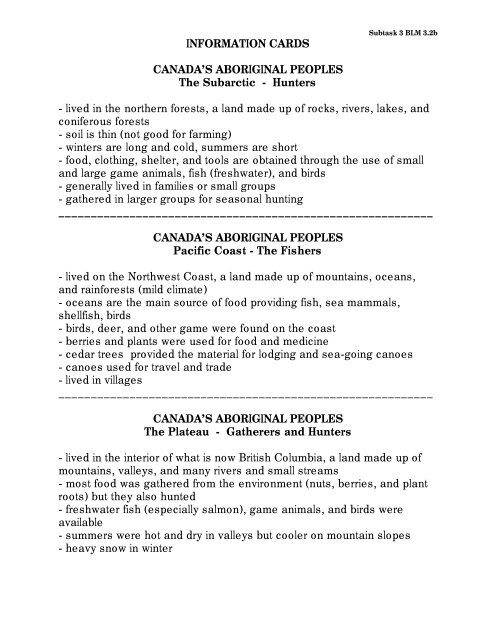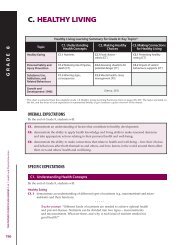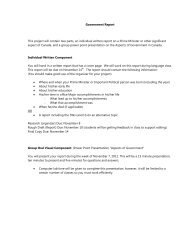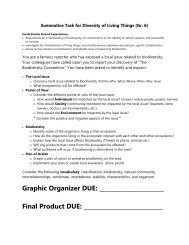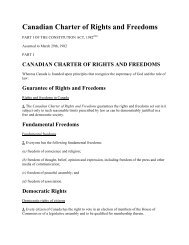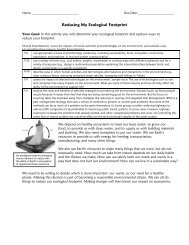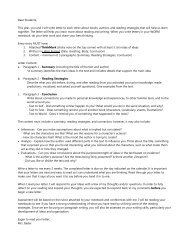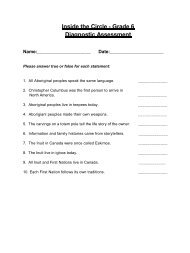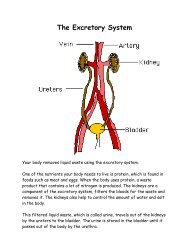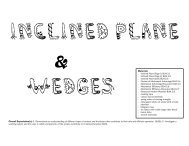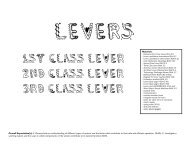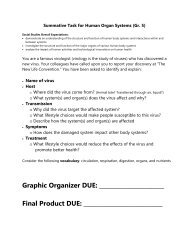INFORMATION CARDS CANADA'S ABORIGINAL PEOPLES The ...
INFORMATION CARDS CANADA'S ABORIGINAL PEOPLES The ...
INFORMATION CARDS CANADA'S ABORIGINAL PEOPLES The ...
You also want an ePaper? Increase the reach of your titles
YUMPU automatically turns print PDFs into web optimized ePapers that Google loves.
<strong>INFORMATION</strong> <strong>CARDS</strong><br />
CANADA’S <strong>ABORIGINAL</strong> <strong>PEOPLES</strong><br />
<strong>The</strong> Subarctic - Hunters<br />
Subtask 3 BLM 3.2b<br />
- lived in the northern forests, a land made up of rocks, rivers, lakes, and<br />
coniferous forests<br />
- soil is thin (not good for farming)<br />
- winters are long and cold, summers are short<br />
- food, clothing, shelter, and tools are obtained through the use of small<br />
and large game animals, fish (freshwater), and birds<br />
- generally lived in families or small groups<br />
- gathered in larger groups for seasonal hunting<br />
__________________________________________________________<br />
CANADA’S <strong>ABORIGINAL</strong> <strong>PEOPLES</strong><br />
Pacific Coast - <strong>The</strong> Fishers<br />
- lived on the Northwest Coast, a land made up of mountains, oceans,<br />
and rainforests (mild climate)<br />
- oceans are the main source of food providing fish, sea mammals,<br />
shellfish, birds<br />
- birds, deer, and other game were found on the coast<br />
- berries and plants were used for food and medicine<br />
- cedar trees provided the material for lodging and sea-going canoes<br />
- canoes used for travel and trade<br />
- lived in villages<br />
__________________________________________________________<br />
CANADA’S <strong>ABORIGINAL</strong> <strong>PEOPLES</strong><br />
<strong>The</strong> Plateau - Gatherers and Hunters<br />
- lived in the interior of what is now British Columbia, a land made up of<br />
mountains, valleys, and many rivers and small streams<br />
- most food was gathered from the environment (nuts, berries, and plant<br />
roots) but they also hunted<br />
- freshwater fish (especially salmon), game animals, and birds were<br />
available<br />
- summers were hot and dry in valleys but cooler on mountain slopes<br />
- heavy snow in winter
CANADA’S <strong>ABORIGINAL</strong> <strong>PEOPLES</strong><br />
<strong>The</strong> Plains - Hunters and Gatherers<br />
- lived on the Plains, an open grass land with limited water sources which<br />
supported some trees and shrubs<br />
- winters were cold and summers were hot with clouds of biting insects<br />
- hunted game for meat, mainly buffalo (of which they used every part to<br />
meet their various needs)<br />
- gathered berries and plants for medicines<br />
- migratory life (they followed the buffalo herds)<br />
__________________________________________________________<br />
CANADA’S <strong>ABORIGINAL</strong> <strong>PEOPLES</strong><br />
<strong>The</strong> Eastern Woodland - Farmers and Hunters<br />
- lived in the Eastern Woodland, good soil for crop growing<br />
- main crops were corn, beans, and squash<br />
- hunted, fished, and gathered plants<br />
- built canoes from wood and bark<br />
-traveled and traded on the rivers<br />
- lived in semi-permanent villages<br />
__________________________________________________________<br />
CANADA’S <strong>ABORIGINAL</strong> <strong>PEOPLES</strong><br />
<strong>The</strong> Arctic - Hunters and Fishers<br />
- lived in the Arctic in a treeless cold desert (tundra) with sparse low<br />
growing vegetation<br />
- winters are long and cold, summers short<br />
- little plant food provided by the tundra<br />
- no trees to provide wood for building<br />
- caribou, musk-oxen, ocean mammals, and fish provided food, clothing,<br />
and shelter
<strong>ABORIGINAL</strong> <strong>PEOPLES</strong><br />
WITHIN GEOGRAPHIC ZONES<br />
(Background Information)<br />
NOTES:<br />
• <strong>The</strong> geographic zones used are those defined by the Government of Canada.<br />
• Some Aboriginal Peoples have different spellings of their names depending on<br />
what resource is used and what time period is being discussed.<br />
• Please keep in mind that Aboriginal Peoples vary as much as the environment<br />
across Canada.<br />
• Aboriginal Peoples have been identified by how they related to their<br />
environment for resources. <strong>The</strong> Aboroiginal Peoples may be identified by one<br />
or more of the following designations: “H” for hunting; “F” for fishing; “FM” for<br />
farming; “T” for trading; “G” for gathering; “P” for planting.<br />
GEOGRAPHIC ZONES<br />
1. PACIFIC COAST (West Coast of British Columbia)<br />
Principal Groups:<br />
1) HAIDA - F, T - Queen Charlotte Islands, only member of Haida language<br />
family.<br />
2) TSIMSHIAN - F, T - mainland coast across from Haida, mouth of Skeena River<br />
3) GITKSAN (GI’KSAN) - F, T - farther inland along the Skeena River<br />
4) NISGA’A - F, T - Nass River basin<br />
5) NOOTKA - F(WHALING) - North Vancouver Island<br />
6) COASTAL SALISH - F, T - mainland opposite Nootka<br />
7) KWAKIUTL - F, T - north of Coastal Salish<br />
8) BELLA COOLA - F, T - north of Kwakiutl<br />
<strong>INFORMATION</strong>:<br />
• mountains trap wet ocean air giving mild temperatures and a lot of light rainfall<br />
• forests so thick that transportation is by canoe along the river<br />
• rainy winters are spent in multi-family longhouses<br />
• traditional ceremony is the potlatch, traditional art forms are totem carving,<br />
painted drums, button art on fabric<br />
• common symbols are raven, killer whale against the sun (Tsimshian)<br />
• animal resources used are salmon, shellfish, great sea mammals, especially<br />
whales
2. PLATEAU (Interior of south British Columbia)<br />
Principal Groups:<br />
1) INTERIOR SALISH - F, H, T - largest group, consists of following five groups<br />
- LILLOOET - F, H, T - in the Lillooet River valley<br />
- THOMPSON - F, H, T - southwest of the Lillooet, in Fraser Valley<br />
- SHUSWAP - F, H, T - largest of the small groups, most northerly, controlled all<br />
of the Fraser River to the Rockies<br />
- OKANAGAN - F, H, T - in Okanagan River valley, most southerly<br />
- LAKE - F, H, T - upper Columbia River<br />
<strong>INFORMATION</strong>:<br />
• great diversity, transition between Prairies and Pacific Coast<br />
• mild but long cold winters, gentle summers<br />
• rainfall varies widely<br />
• land of contrasts from semi-desert in the south to high mountains and dense<br />
forests in the north and green river valleys<br />
• animal resources used are river salmon, mountain goats, sheep, moose, elk,<br />
caribou, deer, bear.<br />
3. PLAINS (south Alberta, Saskatchewan, Manitoba)<br />
Principal Groups:<br />
1) BLACKFOOT (SIKSIKA) - H - east of Rocky Mountains, high plains<br />
2) BLOOD - H - south west of Blackfoot, foothills of Rocky Mountains<br />
3) PEIGAN - H - south of Blood<br />
4) GROS VENTRE - FM - east of Peigan<br />
5) PLAINS CREE - FM - north edge of the Plains<br />
6) ASSINIBOINE - H - all of the space south of the Plains Cree<br />
7) SARCEE - H, FM - north of the Blackfoot<br />
<strong>INFORMATION</strong>:<br />
• often followed the buffalo herds and moved with the seasons, from forest in<br />
winter to prairie in summer<br />
• lived on fertile river banks<br />
• endless grassland, some hills and streams<br />
• animal resources used are antelope, buffalo, bison
4. WOODLANDS (Maritimes, Quebec, north Ontario, into Prairies)<br />
Principal Groups:<br />
1) BEOTHUK - F - Newfoundland<br />
2) MI’KMAQ (MICMAC) - H, F - Nova Scotia, NE New Brunswick, Gaspe Quebec,<br />
P.E.I.<br />
3) MALISEET (MALECITE) - H, F - SW New Brunswick, Quebec<br />
4) MONTAGNAIS - H, F - Quebec / Labrador, north shore of St. Lawrence River<br />
5) NASKAPI (INNU) - H - tundra of NE Quebec and Labrador<br />
6) OJIBWAY (OJIBWA, ODAWA, CREE, CHIPPEWA) - H, FM, G - north shore<br />
of Lake Huron and Lake Superior all the way to the Prairies, Quebec, Ontario,<br />
Manitoba, Saskatchewan<br />
7) ALGONQUIN (ALGONKIN) - H - Ottawa valley<br />
8) ODAWA (OTTAWA) - H, FM, T - Manitoulin Island, Ontario<br />
9) CREE (NORTHERN, SWAMPY) - FM, H - huge area to the north and west of<br />
Ojibway country, southern Hudson Bay<br />
<strong>INFORMATION</strong>:<br />
• harsh vegetation zone<br />
• dense boreal forest, up to tundra-like land in the north<br />
• extreme temperatures, long cold winters, short hot summers<br />
• more than 50 groups of Ojibway are located in Canada, Ojibway and Cree<br />
consider themselves to be one people called the Anishinabe or Human Beings<br />
• animal resources used are moose, deer, bear, beaver, caribou, fish, fowl<br />
(inland lakes), shellfish (east coast)<br />
5. SOUTHEAST ONTARIO/ST. LAWRENCE LOWLANDS<br />
Principal Groups:<br />
1) HURON (WENDAT) -H, FM, T - between Lake Simcoe and Georgian Bay area<br />
2) PETUN (TOBACCO NATION) - H, FM, T - south and west of the Hurons<br />
3) NEUTRAL - H, FM, T - Niagara Peninsula<br />
4) ERIE - H, FM, T - shoreline of Lake Erie<br />
5) IROQUOIS - H, FM, T - (consists of following six groups) Lake Ontario to the<br />
upper St. Lawrence River.<br />
6) MOHAWK - H, FM, T<br />
7) ONEIDA - H, G, FM<br />
8) ONONDAGA - H, G, FM<br />
9) CAYUGA - H, FM<br />
10) SENECA - H, G, FM
11) TUSCARORA - H, G, FM<br />
<strong>INFORMATION</strong>:<br />
• Canada’s most fertile region<br />
• lush, rolling land, rivers, streams<br />
• forests in the north<br />
• temperate, growing season is 140 days, therefore time to plant and cultivate<br />
crops of corn, beans, squash<br />
• animal resources used are deer, beaver, bear<br />
6. MACKENZIE / YUKON RIVER BASIN {SUBARCTIC}<br />
(Yukon, Northwest Territories, Nunavut)<br />
Principal Groups:<br />
1) CHIPEWEYAN - H - inhabited the largest amount of territory, area from northern<br />
Churchill River to Great Slave Lake<br />
2) BEAVER - H - south and west of Chipeweyan, in Peace River basin<br />
3) SLAVE (SLAVEYS) - H - between Great Slave Lake and the Mackenzie River<br />
4) YELLOWKNIFE - H - lakelands from east of Great Slave Lake to east shore of<br />
Great Bear Lake<br />
5) DOGRIB - H - southwest of the Yellowknife, land between the two Great lakes<br />
6) KUTCHIN - H, F - basins of the Pelly and Porcupine Rivers, interior Yukon<br />
7) HAN - H - southern Yukon<br />
8) TUTCHONE - H - southern Yukon<br />
9) SEKANI - H - eastern slopes of the Rocky Mountains, northern Alberta<br />
<strong>INFORMATION</strong>:<br />
• very harsh way of life<br />
• dark forests, barren land, swampy terrain (muskeg)<br />
• long, severe winters<br />
• animal resouces used are migratory animals, caribou, moose
7. ARCTIC (Inuit of northern Yukon and Northwest Territories, Nunavut)<br />
Principal Groups:<br />
1) MACKENZIE INUIT - F, H<br />
2) COPPER INUIT - F, H<br />
3) CARIBOU INUIT - F, H<br />
4) NETSILIK INUIT - F, H<br />
5) IGLULIK INUIT - F, H<br />
6) BAFFIN ISLAND INUIT - F, H<br />
7) QUEBEC INUIT (UNGAVA) - F, H<br />
8) LABRADOR INUIT - F, H<br />
<strong>INFORMATION</strong>:<br />
• frozen land, north of the tree line, north of permafrost line<br />
• nine months of the year is a polar desert covered in snow<br />
• soil always frozen just below the surface, plants take centuries to grow<br />
• in winter, oceans and seas turn to ice<br />
• climate is one of the harshest on Earth<br />
• north: icebergs, mountainous islands, snowfields, glaciers<br />
• south: vast rolling plain, barren land, treeless tundra<br />
• west: low-lying, small bluffs, cone-shaped, ice-cored hills (pingos)<br />
• east: rough and rugged, muskeg (wet bog)<br />
• summer is cool and short, no darkness<br />
• winter is long and cold, no daylight at all except for Northern Lights (Aurora<br />
Borealis)<br />
• growing season only 40 days


